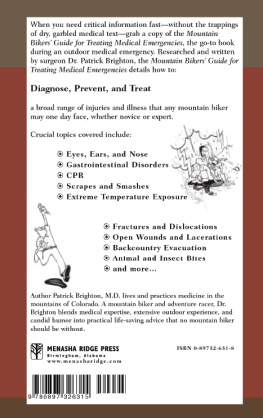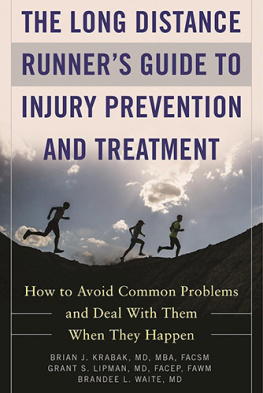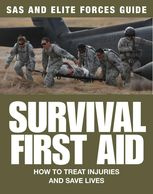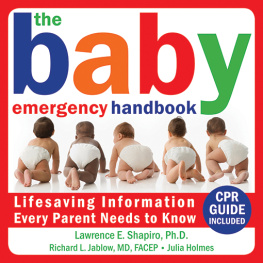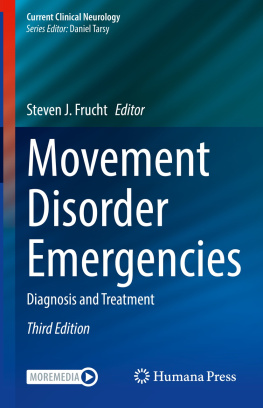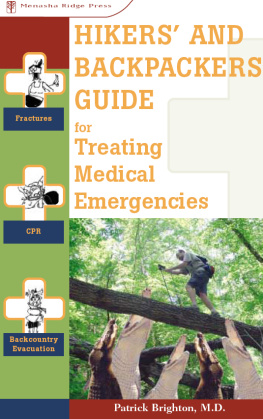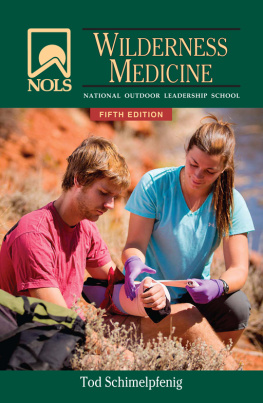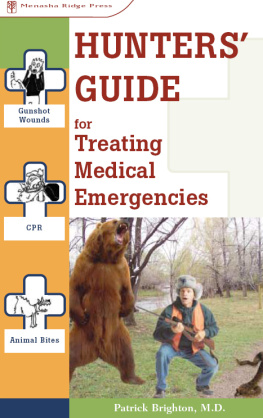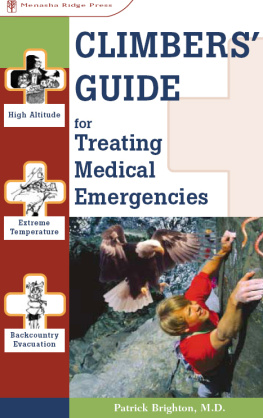
Copyright 2006 Patrick Brighton
All rights reserved
Printed in the United States of America
Published by Menasha Ridge Press
Distributed by Publishers Group West
First edition, first printing
Library of Congress Cataloging-in-Publication Data
Brighton, Patrick, 1962
Mountain bikers guide for treating medical emergencies / Patrick Brighton.1st ed.
p. cm.
ISBN 978-0-89732-631-5
1. First aid in illness and injury. 2. Medical emergencies. 3. Allterrain cyclingAccidents. I. Title.
RC88.9.O95B75 2005
616.025dc22
2005049629
Illustrations by Tami Knight
Text design by Clare Minges
Cover design by Travis Bryant
Menasha Ridge Press
P.O. Box 43673
Birmingham, AL 35243
www.menasharidge.com
ACKNOWLEDGMENTS
Dont you love it when the Academy Award winners launch into a 30-minute speech in which they thank everyone from the person who cuts the hair around their poodles butt to Aunt Marthas financial adviser?
There are, however, a number of people who made this work possible, so if you enjoy any portion of it, send your thanks to them. Firstly, Bob Sehlinger at Menasha Ridge Press, who called me out of the blue and said, Why dont you get off your tokhes and do something constructive? Thats paraphrased, by the way. Also, Russell Helms, Molly Merkle, and the rest of the wonderful Menasha Ridge staff. Next, Tami Knight, who has been kind enough to share with us her unsurpassed wit and insight through her illustrations.
Finally, I would like to say thank you to the person who has been my constant companion for the last ten years, and who has truly shown me what it means to be able to enjoy a peaceful, balanced lifemy dear wife, Kimberley.
INTRODUCTION
To quote George C. Scott in Patton, Mountain biking, God help me but I do love it so. Actually, he substituted war for mountain biking, but lets not quibble over semantics. The point is that very few activities that dont require foreplay are as fun as steering the old fat tires through the dirt. Actually, mountain biking is foreplay for my wife and me, but I digress. Should you find yourself waking frequently in the middle of the night, shaking, drooling, and dreaming of life-threatening downhills, root-jumping, rock-hopping techno trails, or lung-busting climbsyou are a mountain biker, and you had better learn how to help yourself or your buddy when some heinous medical emergency befalls you (note I said when, not ifremember, you are a mountain biker).
Fortunately, most medical issues that relate to mountain bikers are not life-threatening (e.g., broken arms, smashed egos), but not all. It is for these true emergency situations that preemptive knowledge (taking CPR classes, reading this book, watching brain transplants on the Learning Channel) become paramount. For minor emergencies it is easy enough to read about the proper treatment, but it is extremely helpful to have thought through more serious emergency scenarios and the subsequent actions that one might pursue. You might decide, for instance, to ride the spectacular Hermosa Creek Trail in Durango, Colorado, by yourself one day. Well, one of the aspects of the trail that makes it spectacular is the 200- to 300-foot drop-off from the single track that you traverse for several miles. You might conclude that giving a friend an itinerary and taking along a fully charged cell phone would be a good idea (actually, a flare pistol and smoke canisters would be a good idea) in case you endo into the ravine. The possibilities are endless, but the important point is that if you prepare beforehand, bad things usually dont happen.
In the unfortunate circumstance that you or someone in your party develops a life-threatening problem, as difficult as it may be, you must close your eyes, take a deep breath or two, and think before you act (unless a tree is about to fall on your buddy, then go ahead and act first, think later). Really, if something bad has already gone down and you act rashlywith the good intention of doing something quickly to rectify the situationyou may turn a merely serious situation into a fatal one.
Now, with the gloom and doom over with, pedal forth, and may your chain and your butt remain comfortably attached to your bike.
MEDICATIONS
Dispensing
Medicationschemicals synthesized from raw materials ruthlessly extracted from our rapidly vanishing rainforests only to enhance our already pathetically easy existence wait a minute, wrong speech. Anyway, medications really are beneficialeven essential in certain emergency, outdoor settings. Most medications are administered orally ( per os for you Latin speakers). However, certain medications can be administered only by injection, either into a muscle or vein, and still others are given via inhalation, through patches applied to the skin, or by insertion into the rectum (wait a minute, I dont think I know you that well). Most medications (e.g., ibuprofen, Claritin, and so on) are given orally and we are all familiar with taking medications this way. In a medical emergency, however, the victim may not be conscious, may have an obstructed airway, or may not be able to otherwise swallow medications. Do not ever attempt to give a victim medications by mouth under these circumstances, or if you have any concern that a pill may end up in his airway instead of his stomach.
ORAL As discussed above, you may give medications to a person who is awake and cooperative and has a clear airway. Remember, medications given by mouth take at least 30 minutes to take effect, so you would probably not give medications this way in a true emergency.
INJECTIONS This is the most expeditious method of delivering immediately available medications but should be performed only by trained personnel. Improperly administering parenteral (injectable) medications can be much more lethal than not giving any medication. There are only a handful of injectable medications that one would potentially use, and these would typically be administered only in dire emergencies by trained rescue personnel.
INHALANTS Medications delivered by this route usually represent medications that a person takes routinely: asthma or allergy meds, for instance. Medical assistance using these medications usually involves helping a person find their steroid asthma inhaler.
PATCHES There is little reason to administer medications by patch in a medical emergency. The medication absorbs slowly and predictably, usually over 6 to 24 hours. This method requires too much time to be of much use in the short term.
SUPPOSITORIES This is actually an excellent way to administer some medications and to break the ice in certain hard-to-start relationships. As weird as it sounds, medications dissolve and are absorbed in the inside lining (mucosa) of the rectum quite efficiently. This is a handy way to get some drugs circulating in victims who are nauseated or are otherwise unable to take medications by mouth. Antinausea medications and Tylenol are the most commonly administered rectal medications. Two salient technique tips apply here: (1) Make sure the medication and the (one hopes) gloved finger that is placing the suppository are well lubricated (with KY jelly, olive oil, water, or such); (2) Be sure that the medication is positioned at least one to two inches inside the rectum. This will ensure that the medicine is within the confines of the rectum, where it can be absorbed.
Precautions
Here comes the cautionary advice. Please, please, please only carry medications that you personally are familiar with administering: you must completely understand their dosage as well as their possible side effects and potential interactions with other medications.
Next page
